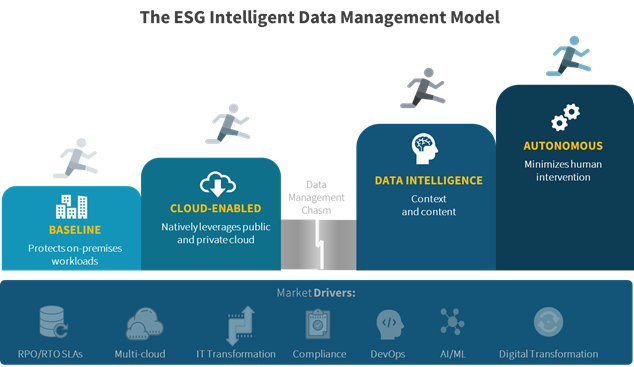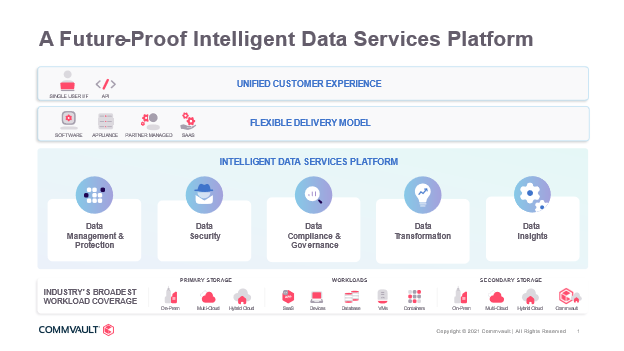 Commvault is celebrating its 25th birthday and what a ride it has been so far! I have to admit that Commvault has a special place in my heart because I pretty much started in this space at the same time and have known the company as a partner and then as a (fringe) competitor for many years when I was on the vendor side.
Commvault is celebrating its 25th birthday and what a ride it has been so far! I have to admit that Commvault has a special place in my heart because I pretty much started in this space at the same time and have known the company as a partner and then as a (fringe) competitor for many years when I was on the vendor side.
The past couple of years are really the most important, in my view, as they totally changed the game for the company. I blogged about this a few times in the past. (Check out my blogs here.)
Commvault’s strategy was revisited by CEO Sanjay Mirchandani, with the effect of fundamentally changing the company’s portfolio, but more importantly its future prospects for many years to come in line with what I see as the fundamental market trend of intelligent data management.
Three years ago or so, I introduced a market maturity model that I call Data Intelligence or Intelligent Data Management. I was frustrated with the amorphism and confusion that existed around the term “data management” as I was concurrently seeing organizations (and vendors) trying to make better use or reuse of their data for incremental business value. We conducted research to inform the model, which essentially presents the evolution of the storage/backup and recovery market into this next phase of intelligent data management.
Market drivers are business and technology-related, and based on the last few quarters, heavily slanted towards digital transformation.

The baseline stage corresponds to on-premises workloads protection. It is the traditional backup and recovery space, one in which software, appliances—physical or virtual—and some services support the desired KPIs, which are the RPOs and RTOs of organizations that leverage these technologies. The market is changing rapidly with the quick adoption of cloud-based technologies to extend traditional on-premises environments. In the context of backup and recovery, it means solutions and technologies that, in time, will seamlessly and natively leverage public and private cloud infrastructures, protecting workloads to the cloud, in the cloud and across cloud and on-premises infrastructure. ESG just conducted research on this topic—so stay tuned!
Data has to be more intelligent to be leveraged. While there is some granular level of understanding of what data is backed up, where it went, how old it is, etc., backup data is not really portable across solutions, is not easily re-usable, and offers very little insight into the data itself. This is where a fundamental change is happening. It’s really about business outcomes and the notion of data as a true asset that can be leveraged to create a return on investment or avoid costs and risks. Our 2019 research shows that intelligent data management will extend or replace their storage/backup infrastructure for a majority of organizations. By the way, it also showed that organizations that classify and reuse their data report positive/improved business outcomes. ESG will very soon be running this research again.
One important aspect to keep in mind is that the requirement for context and content about the data is becoming more acute as new regulations and the need for use of data to support digital transformation are changing the role of data in the enterprise.
The future of backup and recovery is about intelligent data reuse to support new business or technical outcomes, like test/dev/ops, or analytics, for example. We also expect to see artificial intelligence and machine learning integrations enrich the management and quality of the management process.
This is for context to explain why Commvault is “nailing it” and will likely continue to do so, as exemplified by its latest quarterly results. Simply said, the platform can help end-users cross the chasm and here’s why:
- The portfolio covers all workload types one can find in a modern enterprise. Depth and breadth of platform coverage is a good thing to optimize operational efficiency.
- Metallic as a platform is doing increasingly well and seeing substantial customer adoption.
- Commvault is investing in Metallic with the recent support of Dynamics 365, Office 365, and Azure.
- It is also notably combining it with Hyperscale X, which is what Sanjay calls “the power of AND.” In other words, one unified platform that can be “consumed” in a variety of ways and designed for hybrid use cases.
- The secret sauce also has a strong container ingredient, which is essential to the whole thing with the continuing integration of Hedvig. I also expect to see the platform itself more containerized so as to better integrate in the new use cases I discussed earlier, some of which will likely be cloud-resident.
- The platform leverages unified management capabilities with the ability to control both cloud and on-premises from everywhere the customer wants, and then move the data between both easily.
- While still doing substantial business in backup/DR, Commvault is positioning itself squarely in the space of intelligent data management with its Intelligent Data Services, which are essentially what I described 3 years ago in my maturity model.
Commvault’s Intelligent Data Services Platform

I will ask permission to disagree with Sanjay a little bit. It is not just the “power of AND” that matters the most, it is the “power of ANY.” Any platform, any delivery, any (some key ones at least) data services. I expect Commvault to significantly expand its business opportunity with this approach, but it will take continued execution and focus. It will also take new ecosystem partnerships as use cases expand and integrations are needed.
25 years is a long time in this business, but the past two years, in my opinion, have been decisive in establishing a roadmap for the future of the company. I think Commvault’s competitors—old and new—should take notice of how much and how fast the company has transformed and why it is well-positioned to keep expanding its presence in the enterprise space beyond just backup and recovery.







